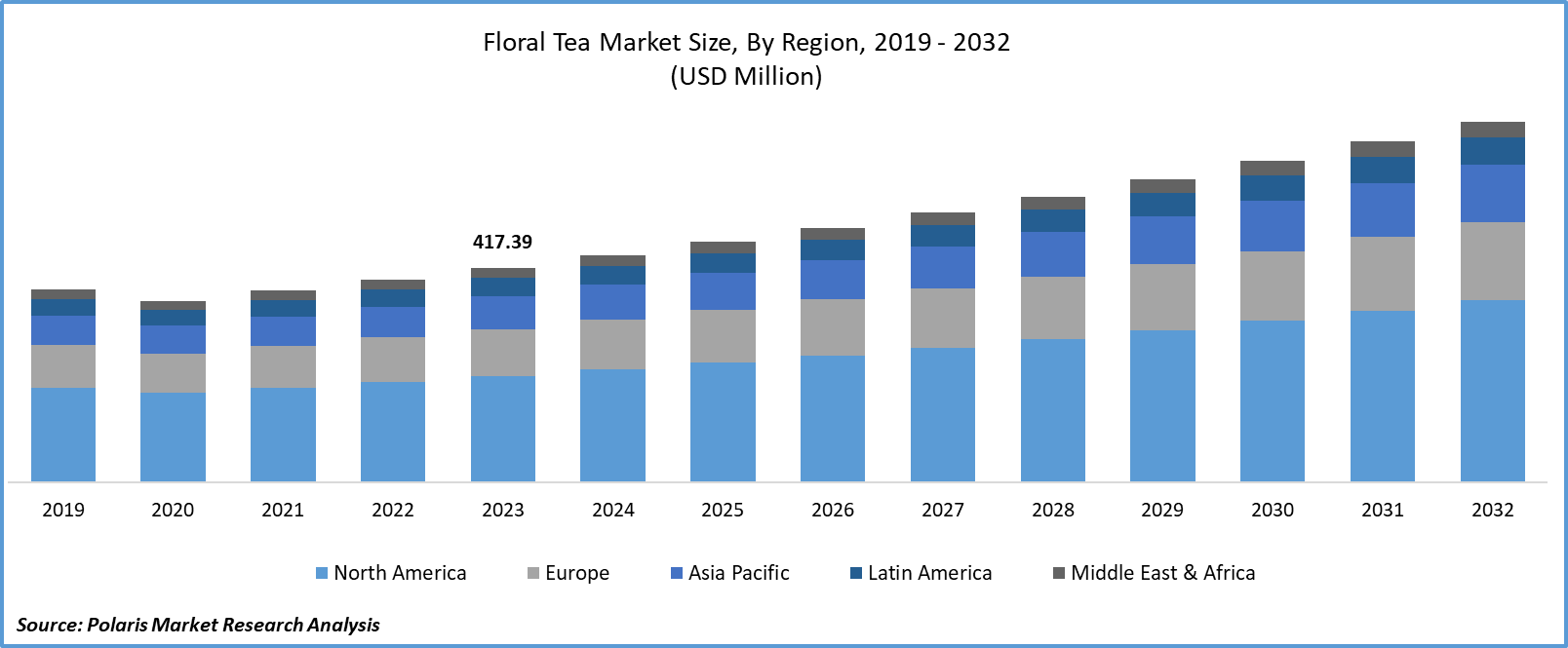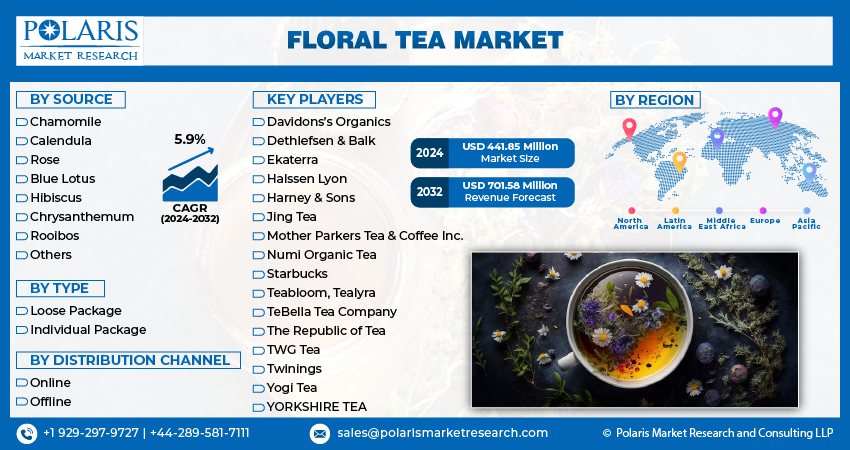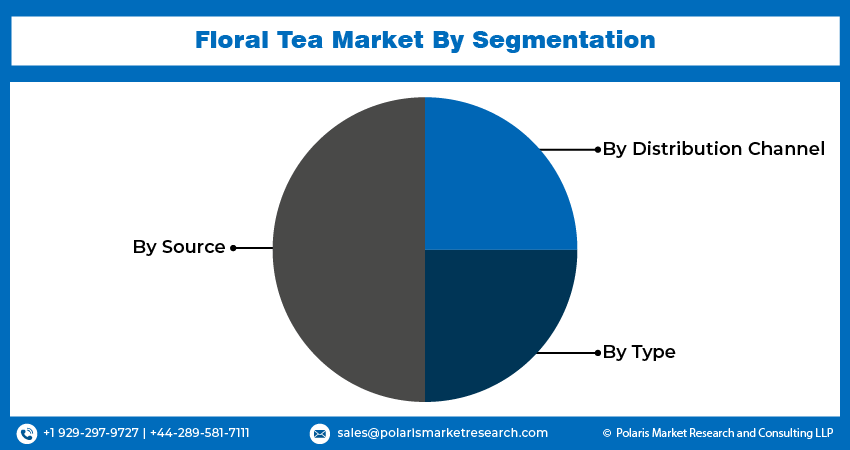
Floral Tea Market Share, Size, Trends, Industry Analysis Report
By Source (Chamomile, Calendula, Rose, Blue Lotus, Hibiscus, Chrysanthemum, Rooibos, and Others); By Type; By Distribution Channel; By Region; Segment Forecast, 2024 – 2032
- Published Date:Feb-2024
- Pages: 117
- Format: PDF
- Report ID: PM4312
- Base Year: 2023
- Historical Data: 2019-2022
Report Outlook
The global floral tea market was valued at USD 417.39 million in 2023 and is expected to grow at a CAGR of 5.9% during the forecast period.
Increase in the number of consumers globally seeking healthier beverage options and opting for floral tea as a natural and highly nutritious choice, as they are rich in antioxidants and other beneficial compounds along with the easy availability of floral tea in a wide range of unique and exotic flavors, appealing to consumers looking for novel taste experiences, are among the leading factors influencing the growth of the market. Additionally, the rising proliferation of effective marketing and promotion strategies in the market with several leading brands and retailers has been highlighting the unique qualities of floral teas, such as their aroma, taste, and potential health benefits, which is likely to foster global market growth.
- For instance, in June 2023, Bigelow Tea introduced three new tea flavors, expanding the Signature Line of teas. It includes Peak Energy Black Tea, Whispering Wildflowers Herbal Tea, & Ginger Honey Herbal Tea, which offers exceptional flavor and features ingredients and nutrients with functional benefits.

To Understand More About this Research: Request a Free Sample Report
Moreover, there are numerous innovations in the functional beverage space worldwide, which have led to the development of floral teas with several specific health benefits, such as teas containing adaptogens like lavender or elderflower for stress relief or digestion-enhancing floral blends, among many others, which in turn, anticipated to open up new growth avenues for the market over the coming years.
However, the limited shelf life of floral teas, especially those that are made up of natural ingredients, limited awareness among low-income and under-developed countries, and their high prices compared to traditional teas are the factors expected to hamper the market growth.
Industry Dynamics
Growth Drivers
Growing demand for herbal products and prevalence for clean label and natural additives driving the market growth
In recent years, the demand for herbal products has emerged drastically with a growing number of individuals becoming aware of numerous potential health benefits of herbal products, including floral teas, as they are widely known as caffeine-free and considered herbal infusions that, makes them suitable for the broader audience especially among health-conscious, which are among the primary factors propelling the global market growth.
Furthermore, the continuous increase in clean label trends across the world, which typically have short ingredient lists with easily recognizable and familiar components and are free from artificial flavors and additives, makes them a highly suitable option for consumers who want a more natural and purer beverage, is further influencing the demand for floral tea worldwide.

Report Segmentation
The market is primarily segmented based on source, type, distribution channel, and region.
|
By Source |
By Type |
By Distribution Channel |
By Region |
|
|
|
|
To Understand the Scope of this Report: Speak to Analyst
By Source Analysis
Blue lotus segment accounted for the notable market share in 2022
The blue lotus segment accounted for the notable market on account of its ability to impart a unique and exotic flavor and aroma to floral tea blends that make it a highly attractive option for tea enthusiasts seeking novel taste experiences. Along with this, blue lotus is known for its rich history of use in several different cultures, such as ancient Egyptian and South Asian traditions, which resulted in its increased interest and could drive sales for the segment product.
The chamomile segment is projected to witness a significant growth rate over the next coming years, mainly attributable to its widespread adoption across the globe due to its potential health benefits, including relaxing as well as calming properties, anti-inflammatory effects, and ability to aid in digestion. Moreover, there are several companies in the market focusing on introducing several new blends and formulations that incorporate chamomile with other flowers, flavors, and herbs, which help them to cater to wider consumer preferences.
By Type Analysis
The loose packaged segment held the significant market share in 2022
The loose packaged segment held a significant revenue share in 2022, which is majorly driven by growing consumer awareness about its capabilities to allow consumers to experiment with the blending and brewing process along with the surging preference for herbal infusions and botanical ingredients that can be easily incorporated by loose package.
Additionally, with consumers worldwide becoming more environmentally conscious, there is penetration for loose teas packaged in sustainable and eco-friendly materials that include biodegradable or compostable packaging options, which resonate with environmentally conscious consumers and align with sustainability standards set by governments.
By Distribution Channel Analysis
The online segment is expected to witness the highest growth over the forecast period.
The online segment is expected to grow at the highest growth rate during the anticipated period, mainly due to the rising number of online shoppers worldwide and the rapid emergence of online shopping platforms across the globe as they offer a convenient way for consumers to purchase floral teas without any need to visit physical stores along with several other beneficial characteristics including easy accessibility from all over the world, a wider range of products, convenient payment methods, and home delivery, among others.
- For instance, according to a recent report, the number of online shoppers in the United States stood at around 268 million in 2022, and the number of online shoppers is projected to reach 285 million by 2025.
Regional Insights
North America region dominated the market with considerable share in 2022
North America dominated the market, which is mainly attributable to owing to growing consumer interest in natural and herbal products over artificial and heavily processed options available in the market, along with the surging concerns about sustainability and environmental impact that make consumers aware of products that promote eco-friendly practices. As people across the region have high spending capacity and disposable income, which allows them to spend more on unique and premium beverage options such as floral teas with exotic and aromatic profiles, the demand for such products has grown drastically.
The Asia Pacific region is anticipated to emerge as the fastest growing region, owing to the robust presence of some of the world’s leading tea-producing and consuming countries such as China, India, and Indonesia, among others, coupled with the greater product adoption as an alternative to artificial and processed beverages.

Key Market Players & Competitive Insights
The floral tea market is moderately competitive, with several companies competing to gain market share and be ahead of their competitors. As a result, companies are significantly focusing on various business expansion and development strategies, including partnerships, collaborations, acquisitions, mergers, and new product developments, allowing them to expand their market and differentiate their products from their competitors.
Some of the major players operating in the global market include:
- Davidons’s Organics
- Dethlefsen & Balk
- Ekaterra
- Halssen Lyon
- Harney & Sons
- Jing Tea
- Mother Parkers Tea & Coffee Inc.
- Numi Organic Tea
- Starbucks
- Teabloom
- Tealyra
- TeBella Tea Company
- The Republic of Tea
- TWG Tea
- Twinings
- Yogi Tea
- YORKSHIRE TEA
Recent Developments
- In September 2023, Organic India introduced new flavors of tea, including sweet rose & Assam black tea. The newly developed tea flavors offer benefits, including antioxidants, energizing, cognitive clarity, and many others.
- In October 2023, Nepal Tea Collective introduced new tea bags that are plant-based & made of 100% non-GMO sugarcane fiber. It will also allow tea drinkers to enjoy the delicious flavors of the tea more conveniently.
Floral Tea Market Report Scope
|
Report Attributes |
Details |
|
Market Size Value in 2024 |
USD 441.85 million |
|
Revenue Forecast in 2032 |
USD 701.58 million |
|
CAGR |
5.9% from 2024 – 2032 |
|
Base Year |
2023 |
|
Historical Data |
2019 – 2022 |
|
Forecast Period |
2024 – 2032 |
|
Quantitative Units |
Revenue in USD million and CAGR from 2024 to 2032 |
|
Segments Covered |
By Product, By Treatment, By End User, By Region |
|
Regional Scope |
North America, Europe, Asia Pacific, Latin America; Middle East & Africa |
|
Customization |
Report customization as per your requirements with respect to countries, region and segmentation. |
FAQ's
key companies in Floral Tea Market are TeBella Tea Company, TWG Tea, Numi Organic Tea
The global floral tea market is expected to grow at a CAGR of 5.9% during the forecast period.
The Floral Tea Market report covering key segments are source, type, distribution channel, and region.
key driving factors in Floral Tea Market are Growing demand for herbal products and prevalence for clean label and natural additives driving the market growth
The global floral tea market size is expected to reach USD 701.58 million by 2032

